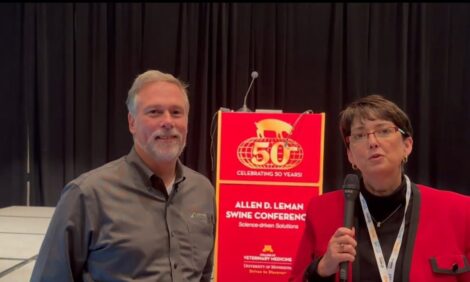



Evaluation of Feeding Budgeting Strategy or Complete Diet Blending on Finishing Pig Growth Performance and Carcass Characteristics
Over- or under-budgeting situations in phase feeding programmes had minimal impact on growth performance, carcass characteristics and net returns, according to Kansas State University researchers. They also found that feeding blended diets to a lysine curve did not improve the pigs' performance and led to reduced total revenue compared to a standard feed budget.A total of 252 mixed-sex pigs (PIC 327 × 1050; initial bodyweight = 79.8 ± 0.9lb) were used in a 95-day growth study to compare feed-budgeting strategies and complete diet blending for finishing pigs on growth performance, carcass characteristics and economics, reported H.L. Frobose and colleagues at Kansas State University to the 2012 Kansas State University Swine Industry Day.
Feed was delivered to all pens of pigs using a computerised feed delivery system (FeedPro, Feedlogic Corp., Willmar, Minnesota) that is capable of delivering and dispensing two separate diets.
Four experimental treatments had nine pens per treatment and seven pigs per pen in a randomised complete block design. Dietary treatments included:
(1) standard 4-phase (0.91, 0.77, 0.67, and 0.61 per cent standardized ileal digestible (SID) lysine, respectively) complete feed programme (Standard)
(2) blending a high- and low-lysine complete diet to meet the estimated daily SID lysine requirement from days 0 to d 95 (Curve)
(3) Treatment 1 diets with 20 per cent greater feed budget allowance per phase (Over), and
(4) Treatment 1 diets with 20 per cent lower feed budget allowance per phase (Under).
Diets were corn-soybean meal–based with no added fat. The standard diet was budgeted at 117, 138, 158, and 175 lb for Phases 1 through 4, respectively.
Overall (days 0 to 95), no differences (P>0.11) were observed in average daily gain, average daily feed intake, feed:gain ratio or final bodyweight among pigs fed the budgeting strategy diets.
Pigs phase-fed a standard phase-feeding program tended to have heavier (P=0.09) hot carcass weight than pigs fed the Curve and tended to have (P=0.10) greater percentage carcass yield than those fed the Curve or the Over diet.
No differences (P>0.14) were observed in percentage lean, fat depth or loin depth.
Pigs fed diets blended to a lysine curve had lower feed costs (P<0.004) than all three phase-feeding treatments but because of heavier hot carcass weights, pigs fed the standard feed budget had greater (P=0.05) revenue per pig and tended to have greater (P=0.10)
income over feed cost under two separate diet and carcass price scenarios than pigs fed with the Curve, with pigs over- and under-budgeted remaining intermediate.
Over- and under-budgeting situations in phase feeding programmes had minimal impact on growth performance, carcass characteristics and net returns, according to Frobose and colleagues. Furthermore, they added feeding blended diets to a lysine curve did not improve growth performance and led to lower total revenue than using a standard feed budget.
Reference
Frobose H.L., J.M. DeRouchey, D. Ryder M.D. Tokach, S.S. Dritz, R.D. Goodband and J.L. Nelssen. 2012. Evaluation of feeding budgeting strategy or complete diet blending on finishing pig growth performance and carcass characteristics. Proceedings of the Kansas State University Swine Industry Day 2012, p365-375.
You can view the full paper in the proceedings by clicking here.
Other papers presented at this conference can be viewed by clicking here.
February 2013






